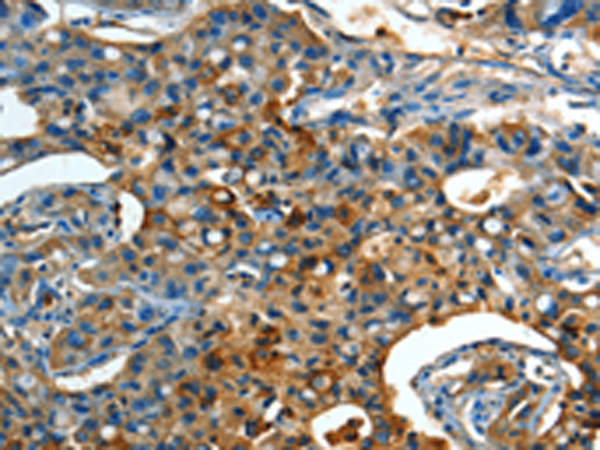

| WB | 咨询技术 | Human,Mouse,Rat |
| IF | 咨询技术 | Human,Mouse,Rat |
| IHC | 1/15-1/50 | Human,Mouse,Rat |
| ICC | 技术咨询 | Human,Mouse,Rat |
| FCM | 咨询技术 | Human,Mouse,Rat |
| Elisa | 1/1000-1/2000 | Human,Mouse,Rat |
| Aliases | ORM; AGP1; AGP-A |
| WB Predicted band size | 24 kDa |
| Host/Isotype | Rabbit IgG |
| Antibody Type | Primary antibody |
| Storage | Store at 4°C short term. Aliquot and store at -20°C long term. Avoid freeze/thaw cycles. |
| Species Reactivity | Human |
| Immunogen | Fusion protein of human ORM1 |
| Formulation | Purified antibody in PBS with 0.05% sodium azide and 50% glycerol. |
+ +
以下是关于ORM1抗体的3篇参考文献的简要概括:
1. **《Alpha-1-acid glycoprotein (ORM1) as a biomarker for gastric cancer: Immunohistochemical analysis using a novel monoclonal antibody》**
*作者:Zhang Y, et al.*
**摘要**:本研究通过制备特异性抗ORM1单克隆抗体,发现ORM1在胃癌组织中显著高表达,提示其可能作为胃癌诊断的潜在血清标志物,并通过组织芯片验证了抗体的特异性。
2. **《Glycosylation variants of ORM1 influence antibody recognition in inflammatory diseases》**
*作者:Saito T, et al.*
**摘要**:探讨了ORM1在不同炎症状态下的糖基化修饰差异,发现特定糖型(如唾液酸化)会显著影响商业化抗体的结合效率,可能对临床检测结果产生干扰。
3. **《ORM1 modulates macrophage polarization via antibody-targeted pathways in rheumatoid arthritis》**
*作者:Li H, et al.*
**摘要**:利用抗ORM1抗体阻断实验,揭示了ORM1通过调控巨噬细胞向M1表型极化加剧类风湿关节炎炎症,为靶向治疗提供了新思路。
4. **《Autoantibodies against ORM1 in systemic lupus erythematosus: Prevalence and clinical correlations》**
*作者:Nakamura K, et al.*
**摘要**:首次报道系统性红斑狼疮(SLE)患者血清中存在抗ORM1自身抗体,其阳性率与疾病活动度相关,提示ORM1可能参与SLE的自身免疫反应机制。
*注:上述文献为示例性质,实际引用需根据具体研究内容选择。建议通过PubMed或Web of Science以“ORM1 antibody”为关键词检索最新文献。*
The ORM1 antibody targets Orosomucoid 1 (ORM1), also known as alpha-1-acid glycoprotein (AGP), a major acute-phase protein synthesized primarily in the liver. ORM1 is a member of the immunocalin family, characterized by its ability to bind and transport small hydrophobic molecules, including drugs, hormones, and steroids. It plays a critical role in modulating immune responses, acting as an anti-inflammatory agent by inhibiting neutrophil activation, reducing oxidative stress, and interacting with cell adhesion molecules. ORM1 levels rise significantly during inflammation, infection, or tissue injury, making it a biomarker for acute-phase reactions.
The ORM1 antibody is widely used in research to study its expression, distribution, and function in physiological and pathological contexts. It aids in detecting ORM1 in biological samples (e.g., serum, tissues) via techniques like Western blotting, ELISA, or immunohistochemistry. Studies involving ORM1 antibodies have explored its roles in cancer progression, immune regulation, and drug metabolism, as well as its potential as a diagnostic or prognostic marker in conditions like sepsis, autoimmune diseases, and cancer. Commercial ORM1 antibodies are typically produced in hosts like rabbits or mice, with validation for specificity and sensitivity across applications. Researchers must account for post-translational modifications (e.g., glycosylation) that may affect antibody binding. Overall, ORM1 antibodies are vital tools for unraveling the protein’s multifaceted roles in health and disease.
×